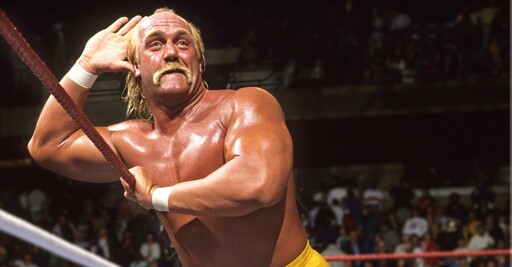The world of professional wrestling includes many types of characters: the tough guy; the masked acrobat; the silent killer; the undersize underdog; the wild man; the high-flying heartthrob; the sex god. Over the course of a pro-wrestling event, which may last a few hours and feature several matches, these roles work in tandem as a type of variety show, giving fans many flavors of entertainment. But over the past half century, the headlining star—the one whose name tops the marquee, and who is paid the most money—has usually been someone like Hulk Hogan. Hogan himself was uncommonly tall, blessed with biceps bigger than a baby’s head, a booming voice, dozens of repeatable catchphases, and a 1,000-watt personality that could be felt from the cheap seats. Both visually and in his affectations, he was what you might come up with if you were to ask 100 strangers on the street, or ChatGPT, to draw the prototypical “pro wrestler.”
Hogan, who died yesterday at the age of 71, is by many objective metrics the most famous pro wrestler of all time. Pro wrestling, as entertainment, has existed since at least the early 20th century. But in the 1980s, Hogan popularized a brash and cartoonish style that became swiftly synonymous with the form, at least in America. When the promoter Vince McMahon built up the company now known as World Wrestling Entertainment (WWE), which transformed the business by becoming the first to broadcast its wrestling show across the country, Hogan was his agent of change—a muscle-bound pitchman who sold a patriotic vision of strength, heroism, and integrity. (As his theme song went: “I am a real American / Fight for the rights of every man.”) Hogan’s superpower was his pure conviction; he embodied outlandishness without a trace of irony, imprinting himself onto the hearts and minds of millions of people, many of them children who would carry their adoration into adulthood.
Most pro-wrestling fans will freely admit that the entertainment is at least a little ridiculous. We’re talking about half-naked men and women in leather underwear and fake tans who pretend to fight one another, their beefs based on storylines as simplistic as I don’t like you. But the unbelievability is part of the point. Pro wrestling offers a digestible fantasy in which good guys usually triumph and villains get their comeuppance. The bad guys aren’t acquitted on technicalities or rewarded for their deviousness; they’re punched in the mouth, before a roaring crowd of thousands. When Hogan became wrestling’s brightest star, this was his essential promise—he was not just a do-gooder who said the right things about loving God and eating your vitamins; he also almost always won. He was like a one-man Harlem Globetrotters, a dazzling showman guaranteed to come out on top. He remained beloved even when he became a bad guy, in the 1990s, popularizing a new archetype of “cool scoundrel” that upended the entire business by making it unclear which side of the good-versus-evil conflict fans should root for. In his case, it was obvious: You rooted for Hulk Hogan.
This success brought millions of dollars, worldwide fame, acting roles, a few restaurants—even as Hogan himself remained something of a cipher. Today, WWE produces hours of behind-the-scenes documentary programming in which its wrestlers speak as themselves. But in that earlier era, when it was not yet publicly acknowledged that the entertainment was predetermined, men like Hogan were careful to stay in character, lest they be judged as phonies. The WWE admitted that the wrestling wasn’t “real” as far back as 1989, but still, Hogan never quite shed the role of “Hulk Hogan”—never casually transitioned into being known by his birth name, Terry Bollea. Even his reality show, which purported to depict his everyday family life, was called Hogan Knows Best. (His ex-wife Linda; his son, Nick; and his daughter, Brooke, all adopted “Hogan” as their public surname, too.)
Hogan generally seemed to be living out some version of his wrestling identity. In a courtroom, he might admit that “Hogan” was a character he played for a living; still, he would say this while wearing his trademark bandanna and bleached-blond goatee. As the years went on and he spent more time out of the wrestling ring—his last match was in 2012, but he hadn’t been a regular performer since 2002—he extended the logic of his character into real life. When in 2013 he sued Gawker for publishing a tape that showed him having sex with his friend’s wife (with the friend’s consent), and eventually won a $140 million judgment, he dominated the court of public opinion by portraying the website as just his latest adversary to overcome. (That the behind-the-scenes circumstances of his lawsuit were more complicated didn’t matter much.) When audio of Hogan using wildly racist invective, from that same tape, was leaked in 2015, he was excommunicated from WWE—“It was unacceptable for me to have used that offensive language; there is no excuse for it; and I apologize for having done it,” he said in a statement—but negotiated a triumphant return to its programming just a few years later. He was sometimes down, but never out; he behaved as though the fans would always be there for him, and they usually were.
This ability to wave away the past and shamelessly present himself for renewed applause was an especially American trait. Like a carnival barker or a veteran televangelist, Hogan wielded his charisma as a cudgel against all criticism. The sordid, tasteless incidents never dinged him for long. Whatever happened then did not matter as much as what was happening now. If he could present as the Hulkster, his muscles rippling and his bandanna tightly strapped on, he could pretend to be the conquering hero even when the truth was more troublesome, more dreary, more human.
In pro wrestling, the ability to stay in character is highly valuable; in real life, it’s sort of obnoxious. (Try affecting the loudest version of your personality, all of the time, and see how many of your loved ones stick around.) But if your paying customers don’t care, there’s little downside to maintaining the illusion for as long as possible. Today, America is inundated with public figures who loudly insist they are one thing when they’re really something else, who stick around mostly because they refuse to go away. We are surrounded by Hulk Hogans, boisterous personalities who commit to their bit as they try to sell something and unabashedly ignore the truth.
Even by the standards of his wrestling peers, Hogan’s ability to stretch the truth was something else. And his belief in himself was rarely shaken; no matter the occasion, he could always snap into character and launch into a bravura monologue. Slowly, though, the covenant between Hogan and those paying customers began to crack. The racist tapes were a major blow, even after WWE brought him back; several Black wrestlers refused to accept his apology, calling him insincere. The ugliness of his remarks is still shocking to revisit today—for many fans, they will be his enduring legacy. And his public alliance with President Donald Trump, which included an absurd pro-wrestling-style speech at last year’s Republican National Convention (“I know tough guys but let me tell you something, brother, Donald Trump is the toughest of them all”), was just as polarizing.
When Hogan made his last WWE appearance earlier this year, on the Netflix debut of the company’s Monday Night Raw, he was resoundingly booed by the Los Angeles crowd. It was an ignoble final interaction with an audience he had helped create, though hardly surprising, given his recent reputation. Even so, he was willing to bet on being forgiven: This year he co-founded the wrestling company Real American Freestyle, whose first show is scheduled for August. Ticket sales were soft, and many pro-wrestling fans derided the concept; still, he was going for it one more time, committing to a character who was no longer believable to anyone but himself.
From The Atlantic via this RSS feed


